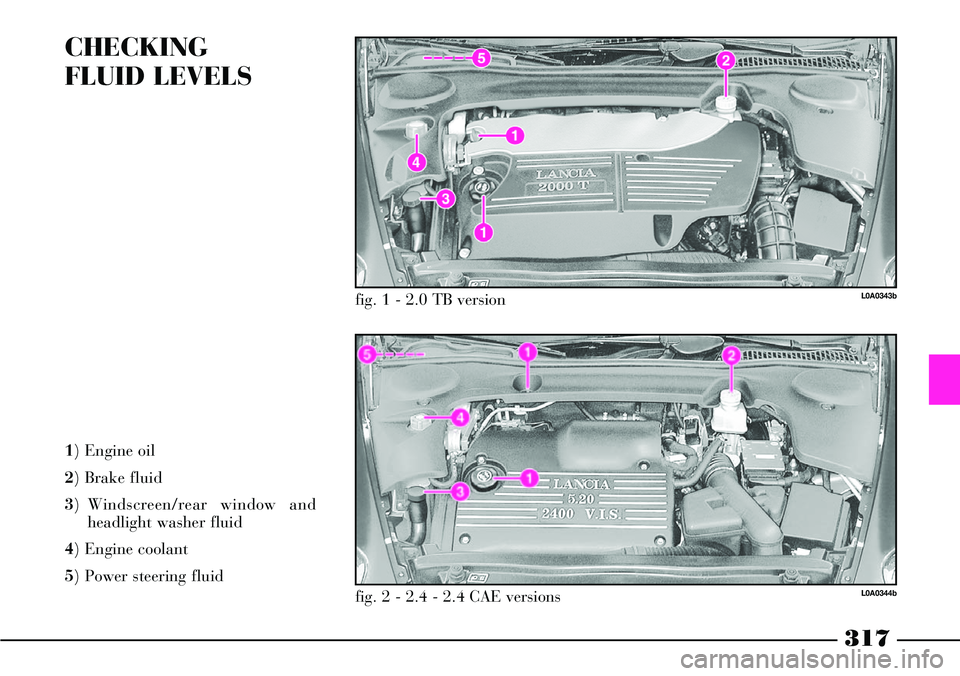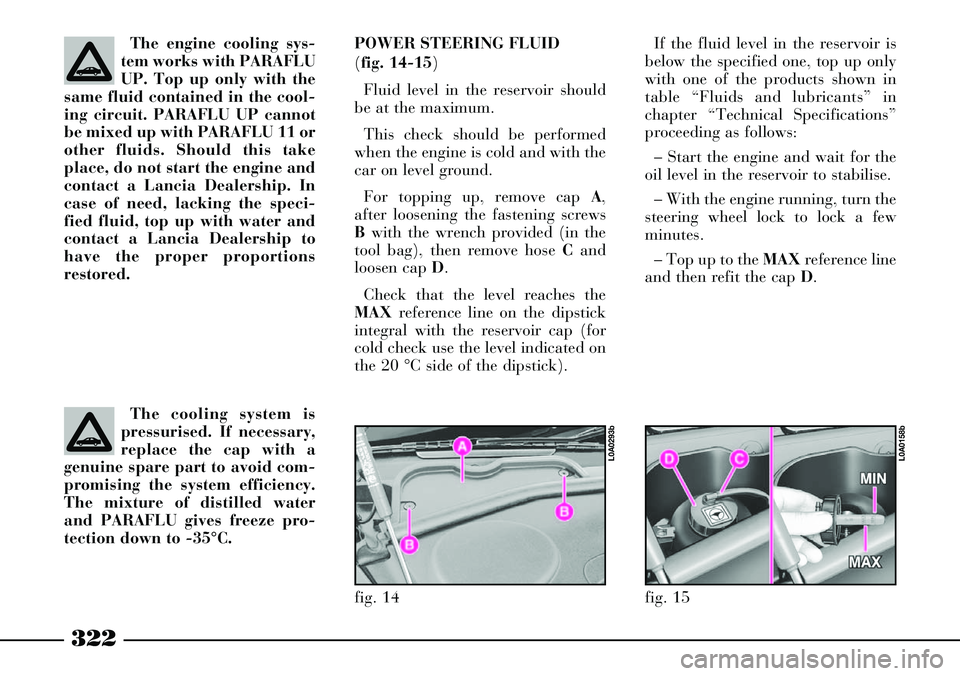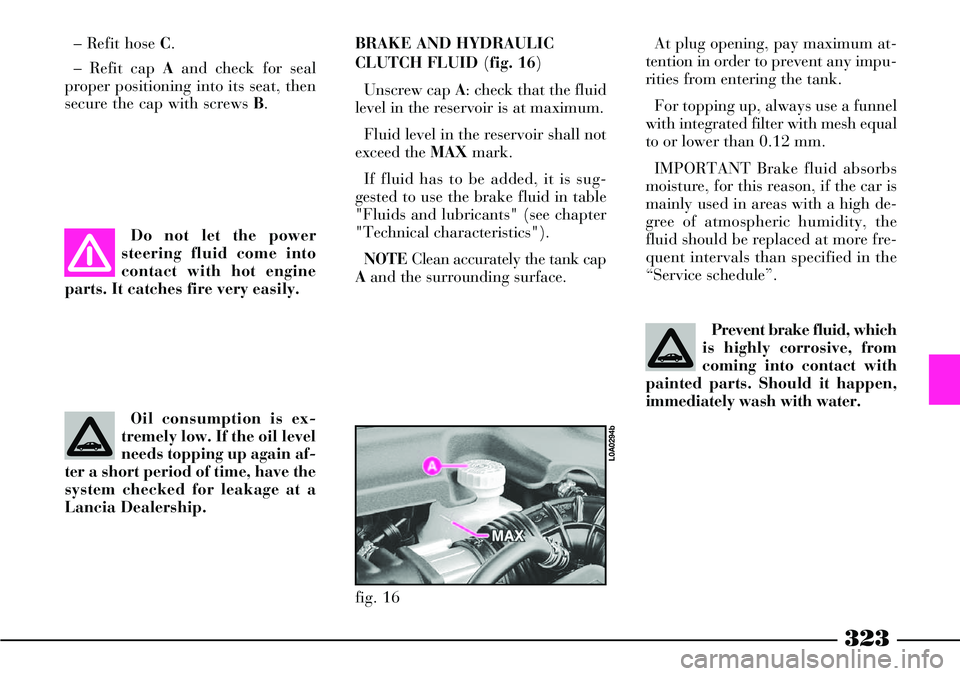Check Lancia Thesis 2007 Owner handbook (in English)
[x] Cancel search | Manufacturer: LANCIA, Model Year: 2007, Model line: Thesis, Model: Lancia Thesis 2007Pages: 386, PDF Size: 8.69 MB
Page 318 of 386

317
CHECKING
FLUID LEVELS
1) Engine oil
2) Brake fluid
3) Windscreen/rear window and
headlight washer fluid
4) Engine coolant
5) Power steering fluid
L0A0343b
L0A0344b
fig. 1 - 2.0 TB version
fig. 2 - 2.4 - 2.4 CAE versions
Page 321 of 386

320
IMPORTANTAfter topping up, let
the engine turn for a few seconds
and wait a few minutes after stop-
ping it before you check the level.
Engine oil consumption
Max. engine oil consumption is
usually 400 grams every 1000 km.
When the car is new, the engine
needs to run in, therefore the engine
oil consumption can only be consid-
ered stabilised after the first 5000 -
6000 km. ENGINE OIL
(fig. 7-8-9-10-11-12)
Check engine oil with the car on
level ground and while the engine is
still warm (approximately five min-
utes after stopping the engine).
Remove dipstick Aand clean it,
than plunge it down and check
whether the oil level is included
between the MINand MAXrefer-
ence lines on the dipstick. The gap
between the MINand MAXrefer-
ence lines corresponds to approxi-
mately one litre of oil.Do not add oil with dif-
ferent specifications (class,
viscosity, etc.) from the oil
already in the engine.
If the oil level is near or even below
the MINline, pour in oil through the
filler hole B, until it reaches the
MAXline.
IMPORTANTIf during a routine
check you will find that the oil level
is above the MAXreference line,
contact a Lancia Dealershipto
have the proper level restored. Be very careful under the
bonnet: you risk burning
yourself. Rememberthat
when the engine is hot, the fan
can start up and cause injuries.
fig. 7 - 2.0 TB version
L0A0323b
fig. 8 - 2.4 - 2.4 CAE versions
L0A0291b
Page 322 of 386

321
IMPORTANTThe oil consump-
tion depends on the driving style and
the conditions under which the car is
used.Used engine oil and re-
placed oil filters contain
substances which can harm
the environment. We recommend
you have the car seen to at a Lan-
cia Dealership for the oil and filter
change. It is suitably equipped for
disposing of used oil and filters in
an environmentally friendly way
that complies with the law.ENGINE COOLANT (fig. 13)
Do not remove the reser-
voir cap when the engine is
hot: you risk scalding
yourself!
Check coolant level when the engine
is cold and with the car on flat
ground. The level should be includ-
ed between MINand MAXreference
lines on the reservoir.
If the level is low, loosen the reser-
voir cap Aand top up with
PARAFLU UPuntil reaching the
MAXreference line.
fig. 9 - 2.4 JTD version
L0A0324b
fig. 11 - 3.0 V6 CAE version
L0A0155b
fig. 13
L0A0292b
fig. 10 - 2.4 JTD 20V -
2.4 JTD 20VCAE versionsfig. 12 - 3.2 V6 CAE version
L0A0346bL0A0359b
Page 323 of 386

322
fig. 14
L0A0293b
fig. 15
L0A0158b
The engine cooling sys-
tem works with PARAFLU
UP. Top up only with the
same fluid contained in the cool-
ing circuit. PARAFLU UP cannot
be mixed up with PARAFLU 11 or
other fluids. Should this take
place, do not start the engine and
contact a Lancia Dealership. In
case of need, lacking the speci-
fied fluid, top up with water and
contact a Lancia Dealership to
have the proper proportions
restored.
The cooling system is
pressurised. If necessary,
replace the cap with a
genuine spare part to avoid com-
promising the system efficiency.
The mixture of distilled water
and PARAFLU gives freeze pro-
tection down to -35°C. POWER STEERING FLUID
(fig. 14-15)
Fluid level in the reservoir should
be at the maximum.
This check should be performed
when the engine is cold and with the
car on level ground.
For topping up, remove cap A,
after loosening the fastening screws
Bwith the wrench provided (in the
tool bag), then remove hose Cand
loosen cap D.
Check that the level reaches the
MAXreference line on the dipstick
integral with the reservoir cap (for
cold check use the level indicated on
the 20 °C side of the dipstick).If the fluid level in the reservoir is
below the specified one, top up only
with one of the products shown in
table “Fluids and lubricants” in
chapter “Technical Specifications”
proceeding as follows:
– Start the engine and wait for the
oil level in the reservoir to stabilise.
– With the engine running, turn the
steering wheel lock to lock a few
minutes.
– Top up to the MAXreference line
and then refit the cap D.
Page 324 of 386

323
Oil consumption is ex-
tremely low. If the oil level
needs topping up again af-
ter a short period of time, have the
system checked for leakage at a
Lancia Dealership.BRAKE AND HYDRAULIC
CLUTCH FLUID (fig. 16)
Unscrew cap A: check that the fluid
level in the reservoir is at maximum.
Fluid level in the reservoir shall not
exceed the MAXmark.
If fluid has to be added, it is sug-
gested to use the brake fluid in table
"Fluids and lubricants" (see chapter
"Technical characteristics").
NOTEClean accurately the tank cap
Aand the surrounding surface.
Prevent brake fluid, which
is highly corrosive, from
coming into contact with
painted parts. Should it happen,
immediately wash with water.
Do not let the power
steering fluid come into
contact with hot engine
parts. It catches fire very easily.
fig. 16
L0A0294b
– Refit hose C.
– Refit cap Aand check for seal
proper positioning into its seat, then
secure the cap with screws B.At plug opening, pay maximum at-
tention in order to prevent any impu-
rities from entering the tank.
For topping up, always use a funnel
with integrated filter with mesh equal
to or lower than 0.12 mm.
IMPORTANT Brake fluid absorbs
moisture, for this reason, if the car is
mainly used in areas with a high de-
gree of atmospheric humidity, the
fluid should be replaced at more fre-
quent intervals than specified in the
“Service schedule”.
Page 327 of 386

326
Batteries contain sub-
stances that are very
harmful for the environ-
ment. You are advised to have the
battery changed at a Lancia
Dealership. It is properly
equipped for disposing of used
batteries in an environmentally-
friendly way that complies with
the law.
With the battery flat, or
after the interruption of
one of the protection
fuses, or if you want to disconnect
a loaded battery (e.g. for a car
stop period), before opening the
luggage compartment bonnet
carefully read and comply with
the instructions contained in the
paragraph “If battery is to be dis-
connected” in the chapter “In an
emergency”.
DUST/POLLEN
FILTER
This filter has a mechanical/elec-
trostatic air filtering action, provid-
ed that windows and doors are
closed.
Have the dust/pollen filter checked
once a year at a Lancia Dealership,
preferably at the onset of summer.
If the car is often used in dusty or
extremely polluted environments,
have the filter replaced more fre-
quently than specified in the Service
Schedule.
IMPORTANTFailure to replace
this filter can significantly reduce
climate control system effectiveness.
BATTERY
The battery is of the “Low
Maintenance” type and is fitted with
an indicator A(fig. 18) for checking
the electrolyte level and battery
charge.
Under normal condition of use top-
ping up the electrolyte with distilled
water is therefore not required. A
periodical check is however neces-
sary to make sure it is in efficient
conditions through the indicator on
the battery cover which should be
dark in colour with a green central
area.If the indicator is a bright colour,
or dark without the green central
area, contact a Lancia Dealership.
fig. 18
L0A0164b
Page 328 of 386

327
If the car is left inactive
for long periods at cold,
remove the battery and
store it in a warm place to pre-
vent freezing.CHECKING THE BATTERY
CHARGE
The quality of the battery charge can be checked through the indicator (where
required).
If the battery is not fitted with electrolyte level indicator, the relevant checks
must only be carried out by authorised personnel.
To check the battery charge, slacken the two fastening screws and open the
cover. Check the battery charge and then reclose the cover, take care to prevent
pinching and short circuits.
Depending on the colour of the indicator, proceed as described in the table
below or on the label B(fig. 18) on the battery. Incorrect fitting of elec-
trical and electronic
accessories can seriously
damage the car. If you want to
add accessories after buying the
car (free-hand phone kit, etc.)
visit a Lancia Dealership. They
can suggest the most suitable
accessories to get and check
whether the electric system can
support the required load or
whether a larger capacity battery
is required.
When working on the
battery or near it, always
wear the proper goggles.
Running the battery with
low fluid level can dam-
age the battery beyond
repair and could also cause its
explosion.
Bright white colour
Dark colour
without green
central area
Dark colour
with green
central areaTop up electrolyte
Low battery
charge
Electrolyte level
and battery charge
sufficientContact a
Lancia Dealership
Charge the battery
(advisable to contact a
Lancia Dealership)
No action needed
Page 329 of 386

328
CHARGING THE BATTERY
IMPORTANTThe battery charg-
ing procedure is described only for
information purposes since this
operation must be carried out by a
Lancia Dealership.
Charging should be slow at a low
amp rating for about 24 hours.
Charging for a longer period of time
may damage the battery.
Before reloading care-
fully read and comply with
instructions contained in
the paragraph “If battery is to be
disconnected” in the chapter “In
an emergency”.
To charge the battery proceed as
follows:
– Disconnect battery negative ter-
minal (–).
– Connect the battery charger wires
to the battery terminals and check
for proper bias.
– Turn the battery charger on.– After charging, turn the battery
charger off before disconnecting it
from the battery.
– Reconnect the battery negative
terminal (–).
The liquid in the battery
is poisonous and corrosive.
Do not let it touch the skin
or eyes. Recharging the battery
should be done in a well-venti-
lated area and away from naked
flames or possible sources of
sparks: explosion and fire risk.
Never attempt to charge
a frozen battery: it must
be thawed first, otherwise
it may explode. If freezing has
took place, the battery should be
checked before charging by spe-
cialised personnel, to make sure
that the internal elements are not
damaged and that the body is not
cracked, with the risk of leaking
poisonous and corrosive acid.IMPORTANTA battery which is
kept at a charge of less than 50% for
any length of time will be damaged
by sulphation leading to a reduction
in cranking power and a higher risk
of the battery electrolyte freezing
(this may even occur at –10 °C). If
the car is inactive for a long period
of time, refer to “Storing the car”, in
chapter “Driving your car”.
REPLACING THE
BATTERY
If required, replace the battery
with a genuine spare part presenting
the same specifications. If a battery
with different specifications is fitted,
the frequencies shown in the Service
Schedule in this chapter will no
longer apply. Refer to the instruc-
tions provided by the battery
Manufacturer.
IMPORTANTBefore opening the
luggage compartment bonnet to dis-
connect the battery, carefully read
and comply with instructions con-
tained in the paragraph “If battery is
to be disconnected” in the chapter
“In an emergency”.
Page 330 of 386

329
USEFUL ADVICE FOR
LENGTHENING THE LIFE OF
YOUR BATTERY
To prevent rapidly draining the
battery and ensure that it continues
to work correctly, the following
should be noted:
– Terminals must always be firmly
tightened.
– Do not keep accessories (e.g.
sound system, hazard lights, parking
lights, etc.).
– When you park the car, ensure
the doors, boot and bonnet are
closed properly. The ceiling lights
must be off.
– Before working on the electrical
system, disconnect the negative
cable from the battery.– If after buying the car, you want
to install electric accessories which
require permanent electric supply,
visit a Lancia Dealership, whose
qualified personnel, in addition to
suggesting the most suitable devices
belonging to the Lineaccessori
Lancia, will evaluate the overall
electric absorption, checking
whether the car’s electric system is
capable of withstanding the load
required, or whether it should be
integrated with a more powerful
battery. These devices in fact take
electricity also when the ignition key
is removed (car parked, engine off),
and can gradually drain the battery.
The overall intake of these devices
(standard and after-market) must
be less than 0.6 mA x Ah (of the bat-
tery), as shown in the following
table.Battery Maximum
idle intake
70 Ah 42 mA
80 Ah 48 mA
100 Ah 60 mA
It is also important to remember
that high intake devices (such as
bottle warmers, vacuum cleaners,
cellular phones, frigo bar, etc.) will
speed up battery discharging when
powered with engine off or running
idle.
– Please note that when installing
additional systems in the car, incor-
rect wiring can be dangerous espe-
cially when concerning safety sys-
tems.
Page 331 of 386

330
SPARK PLUGS
The cleanness and soundness of the
spark plugs are very important for
keeping the engine efficient and pol-
luting emissions down.
The appearance of the spark plug,
if examined by expert eyes, is a good
way of pinpointing a problem even if
it has nothing to do with the ignition
system. Therefore, if the engine has
problems, it is important to have the
spark plugs checked at a Lancia
Dealership.
The spark plugs must be
changed at the times
specified in the Service
Schedule. Only use the type of
plugs indicated. If the heat ratio
is less than required or the life
specified is not guaranteed, prob-
lems can arise.
ELECTRONIC
CONTROL UNITS
When the car is being used normal-
ly, special measures are not neces-
sary.
The following instructions must be
followed very carefully, however, if
you work on the electrical system or
in cases where emergency starting is
necessary:
– never disconnect the battery from
the electrical system while the
engine is running
– disconnect the battery from the
electrical system if you are recharg-
ing it. The modern battery chargers
can discharge voltage up to 20V
– never perform emergency start-
ups with a battery charger. Always
use an auxiliary battery
– be particularly careful when con-
necting the battery to the electrical
system. Make sure that the polarity
is correct and that the connection is
efficient– do not connect or disconnect the
terminals of the electronic control
unit while the ignition key is at MAR
– do not check polarity through
sparking
– disconnect the electronic control
units if you are electrically welding
the car body. Remove the units if
temperatures exceed 80°C (special
operations on the bodywork, etc.).
Modifications or repairs
to the electrical system
carried out incorrectly
and without bearing the features
of the system in mind can cause
malfunctions with the risk of fire.